|
520.624.1300
www.cal-av.com
Mobile Antenna / Mast Spring Assemblies
Research & Test
- Explosive Test Site
 Range Instrumentation Range Instrumentation
- Special Projects
Customer Service
- Contact CAL-AV
- How To Order
- Order Form (PDF)
About CAL-AV
Home
|
 |
Explosive Test Site Range
Instrumentation
(Click photo to enlarge)
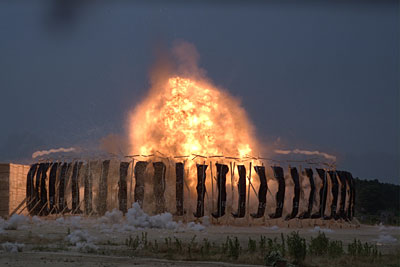
Electronic Detonators (CDUs,
EDUs) and their CONTROLLERS, the combination also known as "firesets."
Capacitive Discharge Units (CDU's),
also known as Electronic Detonator Units (EDU's) consist of circuitry to
charge a capacitor to a high voltage, then to switch the energy in that
capacitor into a low impedance load, typically an exploding bridgewire,
foil, or the like, at the end of a transmission line.
CDU's can be configured as
single-point or multiple-point outputs, the latter for applications where
simultaneous high voltage, high current pulses are required. CAL-AV has
recently delivered a 24-point fireset with simultaneity specified as 1
nanosecond maximum, shown here during assembly:
(Click photo to enlarge)
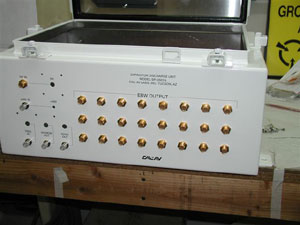
CDU Controllers
Typically, CDU Controllers
are packaged as rack and / or bench-mounted units, intended for indoor
use. CDU's are typically packaged as field hardware and are hardened to a
degree depending on the application.
Two basic configurations of
these units which we have produced are as follows:
-
The CDU Controller unit
is located in a control room, often a bunker or bombproof, and is operated
from AC mains power. It generates both the high voltage and triggering
pulse, which are sent over long cables to the remote CDU. It may also
generate a lower voltage for internal electronics within the CDU,
depending on monitoring requirements.
-
This configuration differs from the first in that AC mains
power is supplied, along with arming and triggering signals, is sent from
the CDU Controller to a remote CDU. The CDU internally generates the high
voltage required to charge its discharge capacitor. A variation of this
latter configuration is that a control signal is used to enable remote
(range) AC mains power to the remote CDU(s).
Test Range Firing Panels
Firing panels recently delivered provided the SAFE-ARM function, firing
current, and built in low-current load test. They feature a count-down /
count up timer, which controls both pre-fire and post fire loads. Control
is based on an opto-isolated microprocessor.
Near-IR Flash Detector, Model SP-1005)
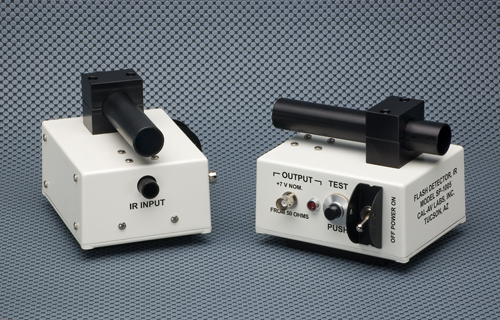
The primary application for this instrument is to supply a timing pulse upon detection of a flash. It has been used with a wide array of flash-producing items, including the following: Small arms, from pistols through small-bore rifles, minigun, and heavier caliber machine guns. Larger caliber tank guns and cannons. Various sizes of mortars. Shoulder-launched weapons. Explosives and flash-bang grenades.
The SP-1005 is typically tripod mounted. It is self-contained, and battery operated. Size is approximately5 x 4.5 x 4.5 inches, overall. It weighs just under 2 pounds. Its output is a nominal 7.5-volt pulse from a 50-ohm source.
Delivery is stock to 45 days, FOB Tucson, AZ
Price is $1,265 per unit.
Other Instrumentation Items
Since 1959, CAL-AV LABS, Inc. has manufactured electronics for research
labs and operational users from government, industry, and universities.
Our efforts are split about evenly between standard instruments and
modified or custom designs. Some selected examples of these efforts that
are related to range instrumentation follow:
(Click photo to enlarge)
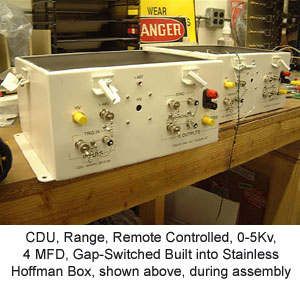
(Click photo to enlarge)
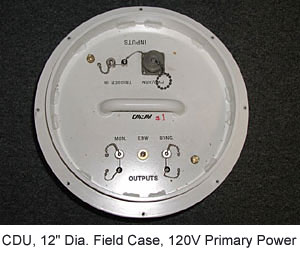
(Click photo to enlarge)
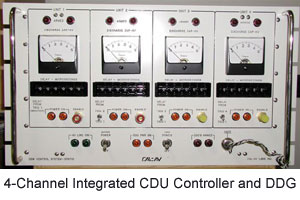

- Acoustic sensors, Navy
- Magnetic sensors, electromagnetic launch (rail gun) programs. Navy,
BAE Systems, NRL
- Firing panels, microprocessor controlled count-down / count up
timer. Navy
- DDG, 150-channel GPIB, HV outputs, early rail gun, Sandia
- CDU, 12" Dia. Field Case, 36V Primary Power. Army, SRI, DOE
- "CRAB" 12" Field case, 120V control for 12 CDU's. SRI, DOE
- 4-Channel CDU Remote Control, 0-5KV. Army, Navy
- 6-Channel Trigger Generator, Make/Break Screen. Navy, Army
- 12-Channel DDG; 1 nS Resolution, GPIB Control, TTL and Fiber
Outputs, 90V Outputs On To and All Delayed Outputs. Range 0-1000 Seconds
for flash X-ray application. Navy
- 30-Channel DDG; similar to above, large pulse-power generation
application. Sandia
- 24-Channel, delay generator, Rubidium clock; 10 nanosecond jitter at
10 minutes out. DECADE Facility, Physics International
- 6-Channel DDG; 0-10 Seconds, 100 nS Resolution. Two 10A Form C relay
outputs with overrun timer on 2 Channels. Explosive range high-speed
photography application. Navy
- Numerous specialized interfaces, signal conditioners, etc.,
utilizing both copper and fiber-optic inputs and outputs.
 Top of Page Top of Page
Voice: 520.624.1300 | Email: Info@cal-av.com
CAL-AV LABS, INC.
2440 N. Coyote Dr, STE 116
Tucson, AZ 85745 USA
Mobile Antenna / Mast Spring Assemblies
Explosive Test Site & Range Instrumentation |
Illuminated Warning Signs |
Special Projects
Home Page |
About CAL-AV |
How to Order
Copyright © 1997- CAL-AV Labs, Inc.
All rights reserved.
Web Design by CS Design Studios
|
 |